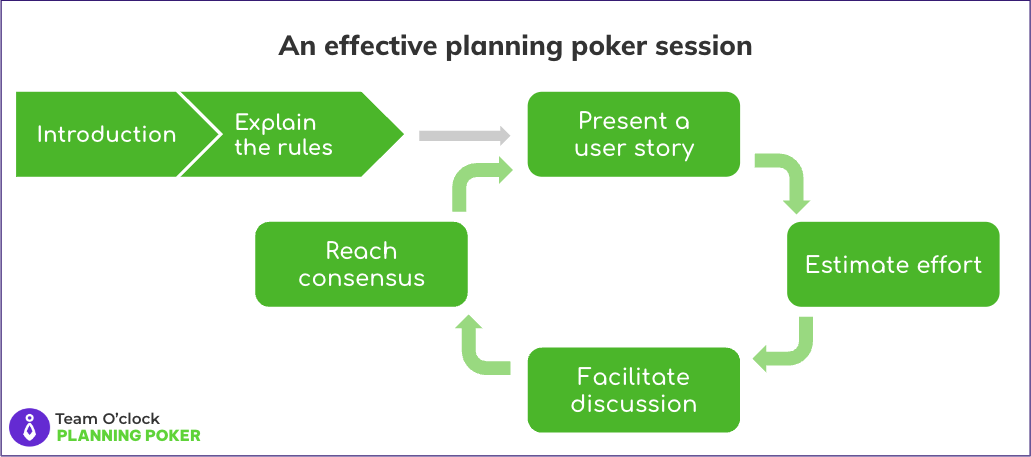
How to Set Up Successful Planning Poker Meetings for Your Remote Team

In today's dynamic business environment, remote teams have become increasingly common. Effective communication and collaboration can be challenging with team members across different locations.
However, with the right tools and methodologies in place, remote teams can still thrive. The Planning Poker method helps promote team alignment, especially when team members are located in different places.
This article will explore how to set up a Planning Poker meeting for your remote team, ensuring productive and engaging sessions. Let's dive in!
What is Planning Poker?
Planning Poker is a collaborative estimation technique used in agile project management. It involves the entire team, including developers, product owners, and stakeholders, to estimate the work needed for each user story or task.
By leveraging the team's collective intelligence, Planning Poker helps generate more accurate estimates and promotes consensus.
Why Use Planning Poker for Remote Teams?
Remote teams often face challenges related to communication and alignment. Planning Poker provides a structured framework for estimation, ensuring all team members have a voice and contribute to the decision-making process.
The transparency and collaboration fostered by Planning Poker can benefit remote teams greatly, leading to better planning, improved accuracy, and enhanced team cohesion.
How to Set up a Planning Poker Meeting the Right Way
Choosing the Right Tools
Selecting the appropriate tools is critical for a successful Planning Poker meeting with your remote team. Several dedicated Planning Poker tools offer user story presentation, voting, and real-time collaboration features.
For example, Team O'clock is a web-based platform that offers structured meetings for agile ceremonies such as retrospectives, daily standups, and Planning Poker estimation sessions.
It is designed for remote teams and offers meeting management, live chat, file sharing, collaboration tools, and mobile access.
Establishing Clear Objectives
Before scheduling a Planning Poker meeting, it is crucial to establish clear objectives.
Determine the purpose of the meeting, whether it's to estimate effort for a specific project, prioritize tasks, or refine user stories.
Clearly defining the objectives helps structure the discussion and ensures everyone is aligned and focused.
Selecting a Facilitator
Assigning a facilitator is essential to ensure a smooth Planning Poker session. The facilitator's role involves the following:
Guiding the team through the estimation process.
Keeping the discussions on track.
Resolving conflicts.
The facilitator should be well-versed in agile principles and familiar with the Planning Poker technique.
Scheduling the Meeting
Choosing the right time for the Planning Poker meeting is crucial, especially when dealing with remote teams across different time zones.
Consider the availability of all team members and try to find a time slot that accommodates the majority. Tools like World Time Buddy can help find overlapping time slots that work for everyone.
Sending Pre-Meeting Materials
Send out pre-meeting materials to ensure all participants are well-prepared for the Planning Poker meeting. Pre-meeting materials may include:
User stories or tasks to be estimated.
Any relevant documentation or specifications.
Instructions on using the Planning Poker tool.
Providing materials in advance allows team members to familiarize themselves with the context and prepare for productive discussions.
How to Run an Effective Planning Poker Meeting
Introducing the Session
Begin the Planning Poker meeting by introducing the purpose and objectives of the session. Briefly explain the Planning Poker technique and its benefits. Set the tone for a collaborative and inclusive environment, emphasizing the importance of active participation from all team members.
Explaining the Rules
Explain the Planning Poker rules to all participants to ensure a smooth estimation process.
Clarify how the estimation scale works, whether it's the Fibonacci sequence (1, 2, 3, 5, 8, etc.) or any other scale chosen by the team.
Ensure everyone understands the concept of relative estimation and the meaning behind each value on the scale.
Presenting User Stories
Present one user story or task at a time to the team. Provide sufficient context, including any relevant details, requirements, or constraints.
Encourage participants to ask questions and seek clarification if needed. Display the user story on a shared screen or through the Planning Poker tool to ensure everyone can see it.
Keeping notes for each task is crucial, especially for remote teams. The notes serve as a reference point to track progress, identify potential roadblocks, and ensure accountability among team members.
They provide a comprehensive record that helps maintain transparency, facilitates effective communication, and promotes alignment toward achieving project goals.
Estimating Effort
Once the user story is presented, ask each team member to privately select an estimation value based on the perceived effort required to complete the task.
Participants can use the Planning Poker tool to cast their votes simultaneously or write their estimates on paper. This simultaneous estimation prevents bias and influence from others' opinions.
Facilitating Discussion
After the initial estimation, facilitate a discussion among team members to understand the reasoning behind their estimates.
Encourage individuals to share their perspectives, assumptions, and any factors they considered during the estimation process.
This discussion promotes knowledge sharing, highlights different viewpoints, and helps align the team's understanding. Keeping notes enables the team to review previous decisions and make any needed adjustments.
Reaching Consensus
In cases where there is a significant difference in estimation among team members, facilitate a discussion to reach a consensus.
Encourage individuals to explain their rationale and consider alternate viewpoints. The goal is to foster collaboration and find common ground that reflects the collective agreement of the team. Repeat the estimation and discussion process if needed until a consensus is reached.

5 Challenges to Overcome in Remote Planning Poker
1. Time Zone Differences
When working with remote teams across different time zones, time zone differences can pose a challenge for scheduling Planning Poker meetings.
To address this, consider rotating meeting times to accommodate different regions. Alternatively, use tools like Doodle or World Time Buddy to find overlapping time slots that work for most of the team.
2. Technical Issues
Remote meetings often encounter technical issues such as audio or video connectivity problems. It is essential to have backup communication channels, such as chat platforms or phone numbers, to ensure smooth communication even if technical difficulties occur.
Encourage team members to test their equipment and connectivity before the meeting to minimize disruptions.
3. Ensuring Active Participation
In remote Planning Poker meetings, it is crucial to ensure active participation from all team members. Encourage everyone to contribute their opinions and ask for feedback from quieter individuals. The facilitator should create a safe and inclusive environment where everyone feels comfortable expressing their thoughts. Consider using round-robin techniques or timeboxing to ensure equal participation.
4. Managing Distractions
Remote work environments can be susceptible to distractions that can hinder the effectiveness of Planning Poker meetings.
Encourage participants to find a quiet and dedicated workspace free from interruptions. Establish guidelines to minimize background noise, such as muting microphones when not speaking. Setting clear expectations can reduce distractions, and the focus can remain on the meeting.
5. Dealing with Language Barriers
In diverse remote teams, language barriers may exist, leading to potential miscommunication or misunderstandings. Ensure that all team members are comfortable expressing themselves in the chosen communication language.
Encourage clarification-seeking questions and provide additional explanations when needed. Be patient and understanding, promoting an inclusive environment that fosters effective communication.
Takeaway
Setting up a Planning Poker meeting for your remote team is a valuable step towards effective collaboration and accurate estimation. You can ensure productive sessions that engage all team members by choosing the right tools and establishing clear objectives.
Overcoming challenges specific to remote teams, such as time zone differences and technical issues, contributes to the success of Planning Poker meetings. By embracing Planning Poker as an estimation technique, remote teams can enhance their planning processes and achieve better project outcomes.
Learn more about Team O'Clock can help you set up a Planning Poker meeting for your remote team with simple steps here.








